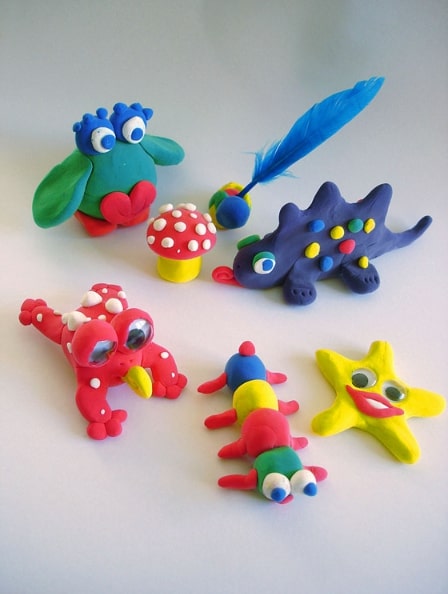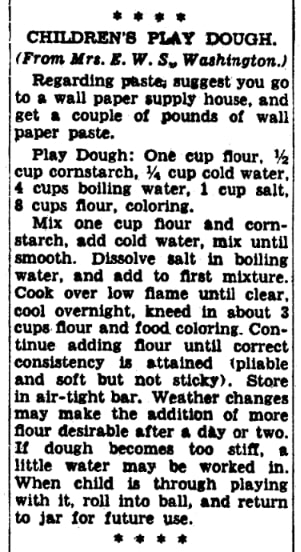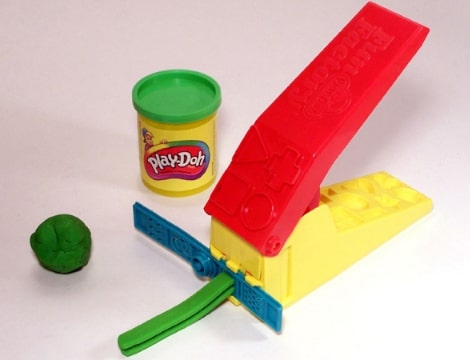Introduction: In this article – in honor of Sept. 16 being National Play-Doh Day – Gena Philibert-Ortega writes about the history of this popular modeling clay for children. Gena is a genealogist and author of the book “From the Family Kitchen.”
Did you know that this past Saturday, September 16, was National Play-Doh Day? This got me to wondering: what memories of childhood toys do you have? Can you conjure up the images of toys you played with? What sounds did they make? Did they have a smell? Most people can recollect the smell of crayons – but there is another toy that has a specific smell that you might remember.

In the early 20th century, a pliable “dough” was sold by Kutol Products as a wallpaper cleaner. Dirty wallpaper was a problem, especially with the use of coal and other non-clean energy sources used to heat a home. But as time marched on and families started to heat their homes with cleaner fuels, they no longer had a need for wallpaper cleaner.
Joseph McVicker was trying to save Kutol Products now that this wallpaper cleaner wasn’t in high demand. His sister-in-law read an article about using wallpaper cleaner as modeling clay, which she then tried out on the nursery school children she taught. The kids loved it.
A look at historical newspapers shows that a recipe published in 1949, and for several years after, encouraged mothers to either use wallpaper cleaner or to make their own play dough to keep their kids busy. (1)
For example, this 1949 recipe begins by suggesting that the reader go to a wall paper supply house to acquire wall paper paste. Those who wanted to could make their own with cornstarch, salt, flour, water, oil and food coloring.

The rest, as they say, is history. A new product named “Play-Doh” was born.
Play Dough in the Newspaper
Play-Doh was initially advertised as a way for busy mothers to occupy their children’s time: “…clean and non-staining, ready to use immediately… may be used over and over again for 3 years… non-toxic and pleasant smelling…”
Once the modeling clay caught on, imitators started selling the compound as well. Play-Doh is the brand name for a specific product whereas “play dough” was used by competitors and in printed recipes.
Play dough was popular with kids. Historical newspapers not only advertised it but also printed letters kids wrote to Santa that included play dough in their lists of must-have toys.
Play in the Kitchen: Making Your Own Play Dough
You can purchase Play-Doh and other brands of modeling clay, but you can also make it at home. The benefit of making it is that your kids can help and customize it. They can create as many color variations as they like. I’ve seen recipes in community cookbooks submitted by moms for the modeling compound, but you can also find recipes in historical newspapers.
This 1997 set of play dough recipes are non-toxic and edible and include the basics found in any play dough recipe: salt, flour, water, and oil. Batches of the dough can be colored using either food coloring or Kool-Aid.
If you want a new idea for using play dough, take a look at this 1972 newspaper article titled “Tips on Crafts for Girl Scouts.” It suggests using the dough to make beads that can be stringed.
National Play-Doh Day
According to one source, 3 billion cans of Play-Doh have been sold since its rebranding as a child’s toy in 1956. (2) Originally sold in one color, white, it later could be found in red, blue, and yellow. Today you can find children’s modeling clay in many different colors and hues. Some even look metallic or sparkle. Beside the modeling compound, you can buy sets that help you create everything from Play-Doh food to ponies. What was true back in 1956 is still true today: play dough helps entertain children and allows them to explore and create.
Explore over 330 years of newspapers and historical records in GenealogyBank. Discover your family story! Start a 7-Day Free Trial
Note on the header image: Play-Doh Fun Factory (Play-Doh is a trademark of Hasbro). Credit: Larry D. Moore, CC BY-SA 3.0, Wikimedia Commons.
_________________________
(1) “The Accidental Invention of Play-Doh,” Smithsonian (https://www.smithsonianmag.com/innovation/accidental-invention-play-doh-180973527/: accessed 11 September 2023).
(2) Ibid.
